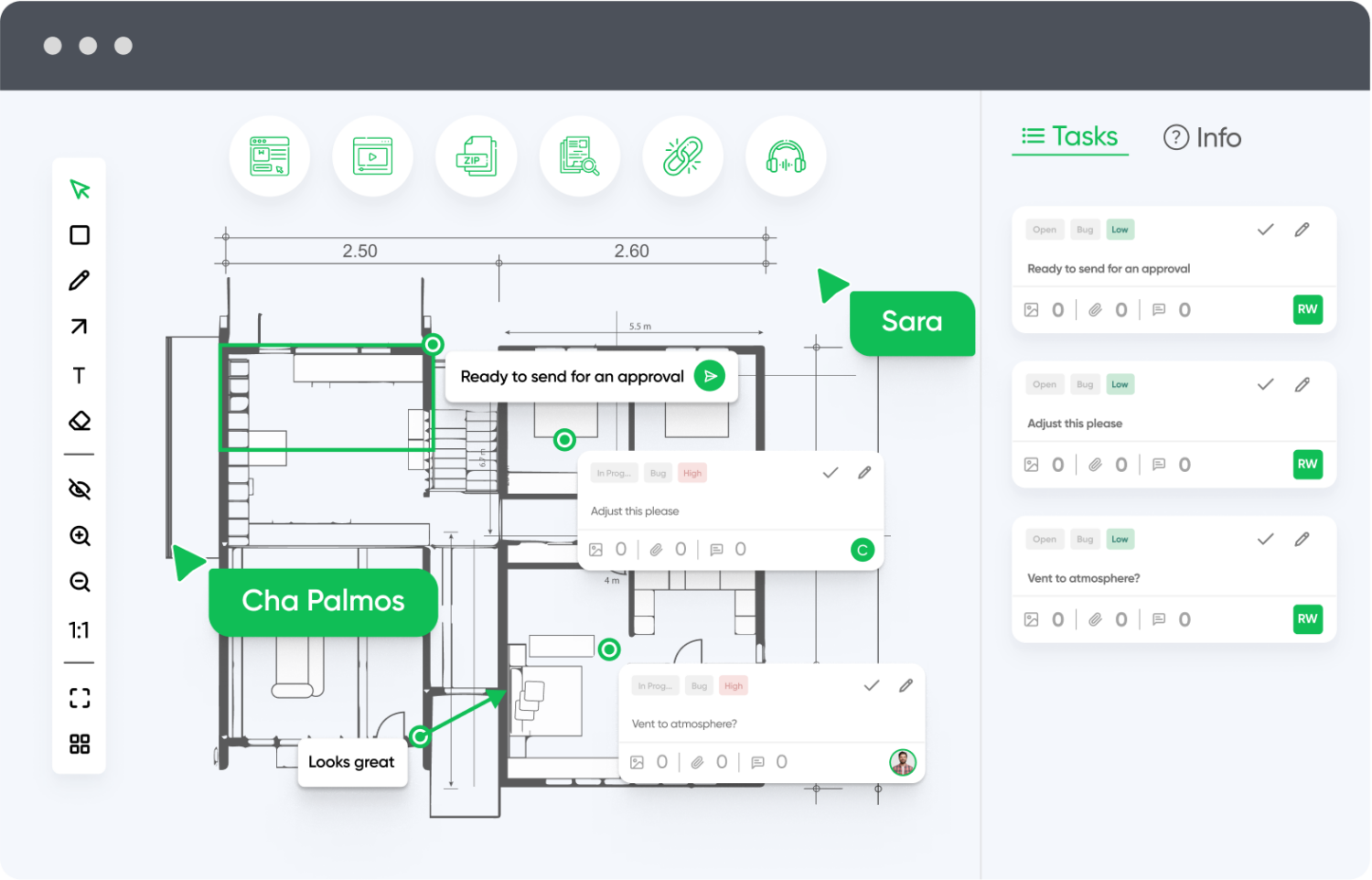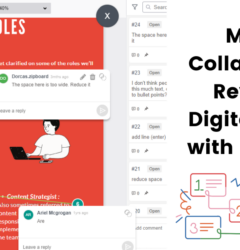Why Your Team Needs a Content Feedback System (Not Just Comments in Docs)
28 May
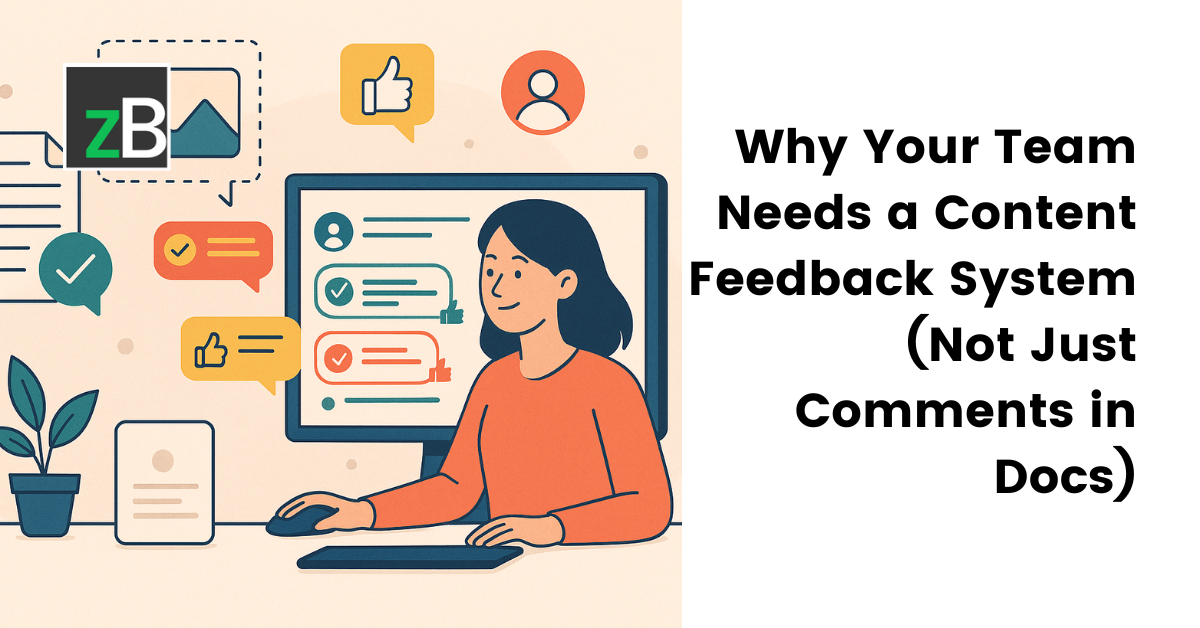
Table of Contents
TogglePicture this: Your team just finished creating what you think is the perfect piece of content. You share it via email, collect feedback through scattered Google Doc comments, chase down approvals through Slack messages, and somehow manage to piece together everyone’s input. Three weeks later, you’re still waiting for final approval, buried under conflicting feedback from different stakeholders who can’t see what others have already suggested.
Sound familiar? You’re not alone. While traditional commenting systems may have served you well in simpler times, today’s complex content creation process demands something more sophisticated: a dedicated content feedback system.
A content feedback system is a centralized platform that streamlines how teams collect, organize, and act on feedback for all types of content, from blog posts and marketing materials to website designs and video content. Unlike scattered comments in documents, these systems provide structure, accountability, and visibility that transforms chaotic feedback cycles into efficient collaboration.
TL;DR
- Traditional document comments create scattered, inefficient feedback loops that slow down content approval
- Content feedback systems centralize all feedback with better organization, tracking, and accountability
- Teams using structured feedback systems significantly speed up approval cycles, often cutting down the time and back-and-forth involved in reviews.
- Key features include visual annotations, workflow management, version control, and integration capabilities
- zipBoard offers comprehensive content feedback solutions with advanced visual annotation tools and seamless integrations
- ROI includes significant time savings, reduced rework costs, and improved content quality
Current State of Content Feedback
Traditional content feedback processes often lead to significant inefficiencies. Many content teams spend a large portion of their time managing feedback and revisions, resulting in lost productivity and delayed project timelines. Lengthy approval cycles remain one of the biggest bottlenecks in content production for marketing teams.
Common pain points plague teams across industries. Feedback gets lost in email threads, stakeholders provide conflicting input without seeing previous suggestions, and version control becomes a nightmare when multiple people edit simultaneously. The situation worsens as teams grow and content becomes more complex, with multi-channel campaigns requiring input from diverse stakeholders including designers, copywriters, legal teams, and executives.
Industry benchmarks reveal that high-performing content teams complete approval cycles faster than their peers, largely due to structured feedback processes. As content creation becomes increasingly collaborative and deadline-driven, the gap between efficient and inefficient teams continues to widen.
Understanding Content Feedback: What It Is and Why It Matters
Content feedback encompasses all input, suggestions, and approvals that shape content from initial concept to final publication. This includes everything from copy edits and design critiques to strategic input and compliance reviews.
The distinction between informal comments and structured feedback is crucial. Informal comments—like those shared in Google Docs or mentioned in passing during meetings—may sometimes lack context, accountability, and systematic organization. Structured feedback, on the other hand, includes clear identification of issues, actionable suggestions, priority levels, and tracking mechanisms.
Quality feedback plays a crucial role in enhancing content effectiveness. Content that undergoes structured and comprehensive review processes tends to perform significantly better in engagement compared to content reviewed through informal, ad-hoc methods. This improvement results from more thorough refinement, clearer messaging, and stronger alignment with audience needs.
The Limitations of Using Just Comments in Docs
Traditional commenting systems create several critical bottlenecks that hinder efficient content creation across multiple dimensions of the feedback process.
Inconsistent Feedback Patterns
Different stakeholders use various platforms and formats to provide input, creating a chaotic feedback landscape. One reviewer might leave detailed Google Doc comments, another sends an email with suggestions, and a third mentions changes during a casual conversation.
This scattered approach makes it nearly impossible to compile comprehensive feedback or ensure nothing gets overlooked. The result is fragmented input that lacks cohesion and often contradicts itself.
Difficulty Tracking Changes and Revisions
Managing feedback becomes exponentially more complex as input accumulates from multiple sources. When several people suggest edits to the same section, determining which changes to implement and in what order becomes a challenging puzzle.
Version control suffers dramatically as people work from different document versions, leading to conflicting edits and lost work that can set projects back significantly.
Lack of Accountability in Feedback
Traditional comment systems create accountability gaps that stall project progress indefinitely. Without clear assignment of feedback tasks or deadlines, reviews drag on without resolution. It’s often unclear who needs to respond to specific comments or when feedback cycles should conclude.
This ambiguity extends project timelines and frustrates team members who can’t move forward without clarity on next steps.
No Centralized View for Team Collaboration
Perhaps most problematically, traditional commenting systems provide no unified dashboard for project oversight. Project managers can’t easily assess overall progress, stakeholders can’t see the complete feedback picture, and team members waste valuable time duplicating efforts or working on outdated versions.
This lack of visibility creates coordination challenges that multiply as team size and project complexity increase.
Ready to Elevate Your Content Feedback Process?
Try zipBoard today and experience streamlined reviews, clear collaboration, and faster approvals—all in one platform.
Start Free TrialBook DemoComparison: Traditional Comments vs. Feedback Systems
| Feature | Comments in Docs | Centralized Feedback System |
|---|---|---|
| Organization | Scattered across platforms | Centralized dashboard |
| Visual Context | Limited to text annotations | Rich visual markup tools |
| Workflow Management | Manual tracking required | Automated workflows |
| Accountability | Unclear assignments | Clear task ownership |
| Version Control | Manual coordination | Automated versioning |
| Reporting | No insights available | Comprehensive analytics |
| Integration | Limited connectivity | Seamless tool integration |
| Accessibility | Platform-dependent | Universal access |
| Search Capability | Basic text search | Advanced filtering |
| Collaboration | Asynchronous only | Real-time collaboration |
What is a Content Feedback System? (And How It Solves These Problems)
A content feedback system is a specialized platform designed to streamline the entire feedback lifecycle for content creation. Unlike general collaboration tools, these systems focus specifically on the unique challenges of content review, approval, and refinement processes.
Effective content feedback systems include several key components that address traditional pain points:
Annotation and Markup Tools
Advanced annotation and markup tools allow reviewers to provide precise, visual feedback directly on content elements. Whether reviewing website designs, PDF documents, or video content, stakeholders can point to specific areas and provide contextual suggestions that eliminate ambiguity.
This visual context ensures everyone understands exactly what needs to be changed and where.
Feedback Management and Approval Workflow
Structured workflows create organization around the review process by establishing clear stages, assigning specific reviewers, setting deadlines, and tracking progress automatically.
Teams can customize approval processes to match their unique requirements while maintaining consistency across projects.
This systematic approach ensures nothing falls through cracks while maintaining project momentum.
Version Control and Content History
Version control features solve the chaos of multiple revisions by tracking every change, maintaining accessible previous versions, and ensuring team members always work from the latest approved version.
This eliminates the confusion and lost work that plague traditional systems, providing complete audit trails for compliance and reference purposes.
Centralized Review Dashboard
Comprehensive dashboards provide project managers and stakeholders with complete visibility into feedback status, pending approvals, and project timelines.
This bird’s-eye view enables proactive management and prevents bottlenecks before they impact deadlines, while giving everyone a clear understanding of project progress and next steps.
Ready to Elevate Your Content Feedback Process?
Try zipBoard today and experience streamlined reviews, clear collaboration, and faster approvals—all in one platform.
Start Free TrialBook DemoKey Benefits of a Content Feedback System for Teams
Implementing a dedicated content feedback system delivers measurable improvements across multiple dimensions of content creation:
Streamlined Feedback Process for Faster Approvals
The most immediate benefit is dramatically reduced approval cycles through structured workflows that eliminate back-and-forth confusion.
Teams typically experience significantly faster approval times within the first month of implementation, as organized processes replace the chaos that characterizes traditional feedback methods.
Clear stages and automated processes keep projects moving forward without manual coordination overhead.
Improved Collaboration and Accountability
Systematic feedback management naturally enhances team collaboration by creating clear ownership and responsibility structures.
When every comment has a designated owner, deadline, and status, team members take greater ownership of their responsibilities.
This accountability extends to feedback quality, as structured systems encourage more thoughtful, actionable input rather than vague suggestions that slow down progress.
Centralized Feedback Management
Unified feedback collection eliminates the detective work of tracking down scattered input from multiple sources.
Project managers can instantly see all feedback, identify patterns, and make informed decisions about implementation priorities.
This visibility also helps prevent conflicting feedback from reaching content creators, reducing confusion and unnecessary rework that extends project timelines.
Enhanced Content Quality and Consistency
More thorough, systematic review processes result in higher quality content that better serves strategic objectives.
When feedback is comprehensive and well-organized, creators can make more informed improvements that align with brand guidelines, audience needs, and business goals.
This systematic approach ensures consistent quality standards across all content types and channels.
Try zipBoard for Free or Book Demo to Transform Your Content Feedback System.
No Credit Card Required
Book DemoStart Free TrialROI of Content Feedback Systems
The financial impact of implementing a content feedback system extends far beyond immediate time savings, delivering measurable returns across multiple business dimensions:
Reduce Project Coordination Time by Hours Per Week
Content feedback systems dramatically reduce coordination overhead and approval cycle duration.
Teams transform lengthy approval processes into streamlined workflows, saving substantial hours per project that can be redirected toward strategic initiatives and creative development.
Cut Operational Costs Through Fewer Revisions
Systematic feedback management reduces rework and project expenses through fewer iterations.
Teams can produce more content with existing resources, effectively increasing capacity without additional hiring costs while capitalizing on time-sensitive opportunities.
Boost Content Performance and Marketing ROI
Content receiving structured feedback consistently performs better across engagement metrics.
This improved performance translates to higher conversion rates, stronger brand perception, and reduced need for post-publication revisions.
Improve Team Satisfaction and Reduce Turnover
Organized feedback processes decrease daily workflow friction, leading to higher productivity and better creative output.
Happy teams stay longer, reducing recruitment costs while maintaining valuable institutional knowledge.
How to Choose the Right Content Feedback System for Your Team
When evaluating a content feedback system, focus on how well it fits your team’s workflow, content formats, and collaboration needs. Key criteria to consider:
- Content compatibility: Supports the formats your team works with (e.g., documents, images, websites, videos).
- Ease of use: Intuitive interface for all stakeholders, minimizing training time.
- Permission controls: Role-based access to manage who can view, comment, edit, or approve content.
- Integrations: Connects with tools your team already uses (e.g., Slack, Outlook, MS Teams, PM tools like Jira and Wrike).
- Collaboration flow: Enables real-time or asynchronous feedback and clear approval workflows.
- Automation: Provides alerts, status updates, and reporting to keep projects on track without manual follow-ups.
Why zipBoard Excels as a Content Feedback Solution
zipBoard stands out by offering a complete, visual-first solution for managing content reviews across diverse formats and workflows. Here’s how it supports teams end-to-end:
Customizable Workflows
Adapt zipBoard to your team’s review process, not the other way around. From simple two-step approvals to multi-phase stakeholder workflows, zipBoard flexibly supports your content lifecycle.
Don’t want to start from scratch?
Try zipBoard’s ready-to-use templates with pre-built phases, project statuses, and task types—designed to help you launch faster and stay organized from day one.
Explore templates now and streamline your setupEnterprise-Grade Security and Permissions
With granular access controls, audit trails, and compliance features, zipBoard is built to protect sensitive content while ensuring only the right people can view, comment, or approve.
Visual Context Reduces Miscommunication
Markup tools allow teams to leave feedback directly on the content—not in separate threads—making feedback clearer, faster, and far less prone to misinterpretation.
Cross-Browser & Device Testing
Review web content and applications in multiple browsers and devices from one platform. Ideal for teams working on responsive or cross-platform experiences.
Built-In Task Management
Convert comments into actionable tasks, assign them to team members, and track progress without switching platforms. Priorities and deadlines help keep reviews on schedule.
Reporting & Analytics
Use built-in dashboards to analyze feedback trends, identify bottlenecks, and improve processes over time with data-driven insights.
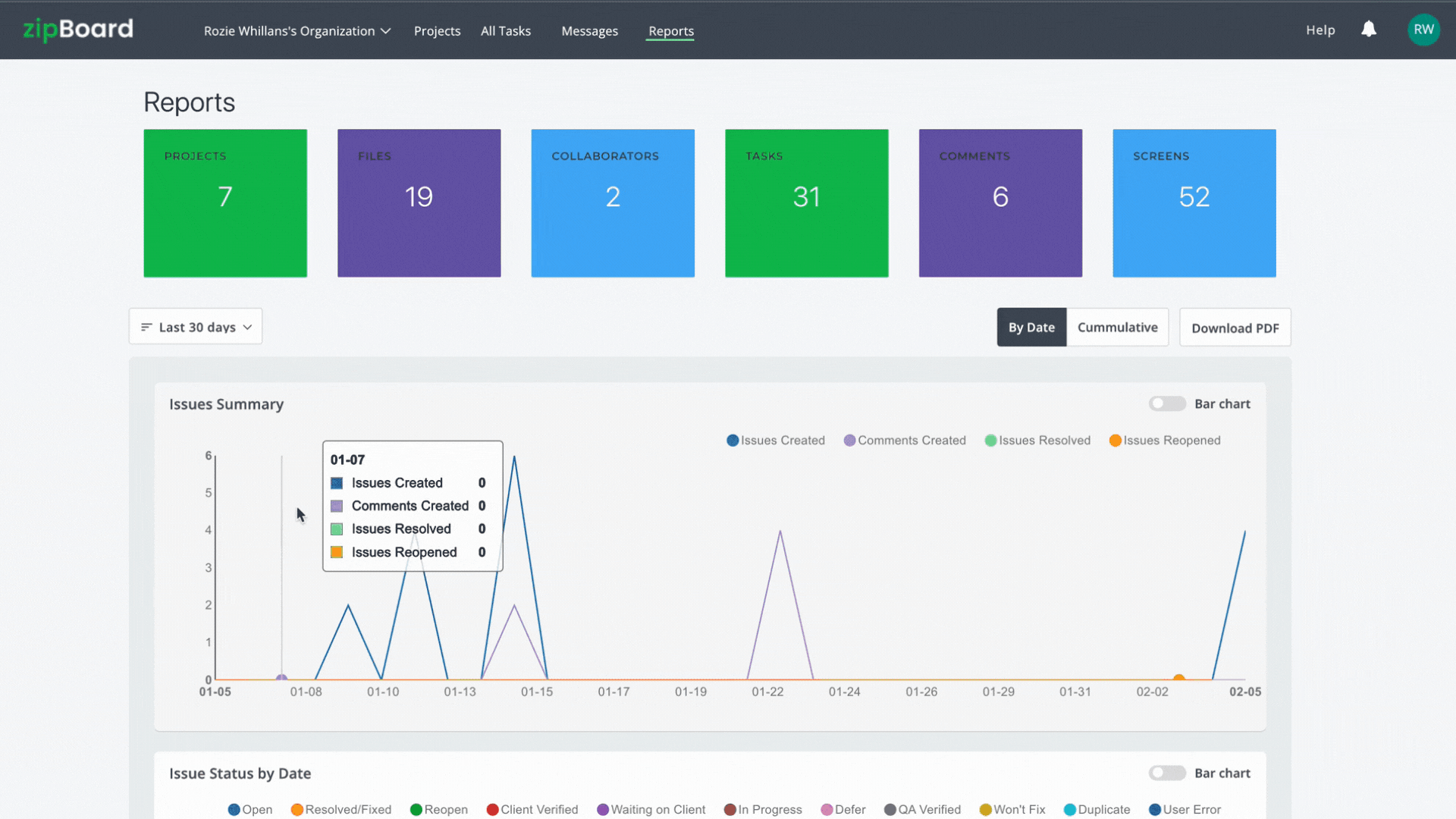
AI-Enhanced Feedback
Leverage AI features to automatically categorize feedback, highlight potential issues, and streamline review cycles through smart suggestions.
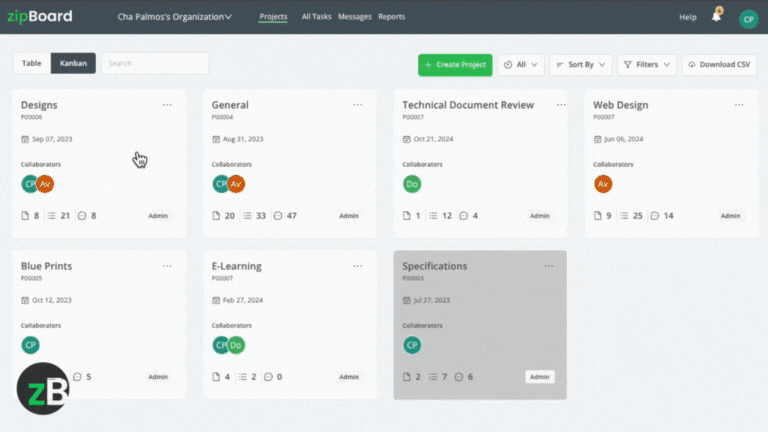
Want to see how zipBoard fits into your stack?
Check out all available integrations to keep your team in sync and your reviews efficient.
Explore all integrations now.API & SSO Support
Need custom integrations? zipBoard’s API and single sign-on (SSO) features make it easy to connect securely with your existing systems.
Ready to Simplify Content Reviews?
Whether you're managing complex feedback cycles or just tired of messy comment threads, zipBoard gives your team a better way to collaborate. Start your free trial today and experience streamlined, visual feedback that actually moves projects forward.
Start Free TrialBook DemoContent Feedback System Implementation Challenges and How to Overcome Them
Rolling out a content feedback system can be challenging—but with the right approach, it doesn’t have to be.
- Resistance to Change: Teams often cling to familiar (but inefficient) processes. Overcome this by starting small—run a pilot project and showcase quick wins to prove value early.
- Training & Onboarding: Don’t rush adoption. Begin with early adopters who can champion the tool internally. Offer simple, hands-on training and easy access to help resources.
- Workflow Integration: Map your current process before implementing. Identify key integration points and introduce the system gradually—enhancing, not disrupting, existing workflows.
- Realistic Timelines: Allow 2–4 weeks for full adoption. Set clear expectations and avoid rushing—slow, steady rollouts stick better than fast, forced ones.
- Change Management: Communicate the “why,” not just the “what.” Get leadership involved, support your team throughout, and celebrate early success to build momentum.
Need Help with Rollout?
Get a guided demo and see how zipBoard can fit seamlessly into your team's workflow.
Book DemoPractical Examples: How Teams Use Content Feedback Systems
- Use visual annotation tools to give precise feedback on design, color, and layout
- Ensure brand consistency through structured workflows
- Shorten feedback loops for faster campaign delivery
- Manage feedback from SMEs, designers, and compliance reviewers in one place
- Annotate diverse content formats—from PDFs to interactive modules
- Use version control to track updates and avoid confusion
- Review live websites and prototypes with real-time feedback
- Run cross-browser checks within the feedback system
- Use visual markup to reduce miscommunication and minimize rework
See how your team can streamline content reviews with zipBoard
Start your free trial today or schedule a demo.
Book DemoStart Free TrialTips for Getting the Most Out of Your Content Feedback System
Set Clear Review Guidelines
Ensure all stakeholders understand what effective feedback looks like. Define expectations around specificity, tone, response times, and how to mark priority. This consistency helps avoid confusion and unnecessary revisions.
Organize with Tags and Categories
Use consistent tags to classify feedback by content type, project phase, or urgency. This improves searchability and keeps your feedback system scalable as the number of assets and collaborators grows.
Establish a Feedback and Approval Workflow
Create a structured review process with defined stages—such as draft, review, and approval. Assign roles for each phase and use automated notifications to keep everyone on track without micromanagement.
Review and Optimize Regularly
Treat your feedback system as a living process. Analyze how it’s being used, spot bottlenecks, and adjust workflows accordingly. Continuous refinement leads to better collaboration and faster turnaround.
Ready to Streamline Your Content Feedback Process?
Start your free trial with zipBoard and experience organized, actionable feedback across all your digital content—no setup hassles, just better collaboration.
Start Free TrialBook DemoFuture Trends in Content Feedback Systems
AI-Assisted Feedback and Recommendations
AI is starting to play a larger role in content feedback systems by offering automated suggestions for improvement. These tools analyze content and past feedback to highlight potential issues—often before a human reviewer sees them—streamlining review cycles and reducing delays.
Predictive Feedback Based on Historical Data
Future feedback systems will become smarter by learning from past projects. They’ll be able to suggest the best reviewers, flag common issues early, and even estimate timelines based on historical data, helping teams plan more accurately and avoid bottlenecks.
Advanced Visualization and Reporting
As feedback systems evolve, their reporting capabilities will become more sophisticated. Visual dashboards will give teams deeper insights into how feedback is shared and used, helping identify process inefficiencies and areas for improvement.
Feedback Tied to Performance Metrics
The next generation of feedback tools will connect directly to content performance metrics. Teams will be able to see how specific feedback leads to improved engagement, conversions, or learning outcomes—closing the loop between input and impact.
FAQs About Content Feedback Systems
A content feedback system is a platform that helps teams collect, organize, and act on feedback efficiently—using tools like visual annotations and structured workflows instead of scattered emails or comments.
Be specific, actionable, and clear. Use visual markup to highlight issues, suggest improvements, and align feedback with content goals.
- Feedback collection (e.g., annotations, comments)
- Workflow management (e.g., approvals, task assignments)
- Reporting and insights (e.g., tracking and analytics)
Teams often cut approval times by up to 60%, reduce coordination overhead, and boost content quality. Most see a return on investment within 3–6 months.
Conclusion
The evolution from scattered comments to structured content feedback systems represents more than a technological upgrade—it’s a fundamental shift toward more efficient, accountable, and results-driven content creation. As content becomes increasingly central to business success, teams that embrace systematic feedback processes gain significant competitive advantages through faster time-to-market, higher quality output, and improved collaboration.
The benefits extend beyond immediate efficiency gains. Structured feedback systems create learning organizations where insights from each project inform future improvements. Teams develop better communication patterns, stakeholders provide more valuable input, and content creators can focus on innovation rather than coordination chaos.
The transition to a dedicated content feedback system requires initial investment in time and training, but the returns compound quickly. Teams that make this shift consistently report not just faster approval cycles, but more enjoyable creative processes and higher satisfaction across all stakeholders.
Transform Your Team's Content Feedback Process Today
Try zipBoard free for 14 days or book a personalized demo to see how structured feedback can revolutionize your content creation workflow.
Book DemoStart Free TrialAuthor’s bio:
Dorcas Kpabitey is a Content Marketing Specialist at zipBoard. She began her content marketing journey alongside her BA in Political Science and Spanish at the University of Ghana. If she’s not tapping away at her keyboard or spending time on Twitter and LinkedIn, she spends her day reading articles, newsletters and books.
Recent Posts
- MEP Document Management: How to Streamline Reviews & Avoid Rework October 3, 2025
- What Is Online Proofing Software? And Why Content Review Breaks Without It July 11, 2025
- How Laerdal Medical Cut eLearning Review Time by 50% with zipBoard’s Visual Review Tool July 9, 2025
- Why Your Team Needs a Content Feedback System (Not Just Comments in Docs) May 28, 2025
- Content Approvals Are Slowing You Down — Here’s the Fix May 26, 2025
©️ Copyright 2023 zipBoard Tech. All rights reserved.
